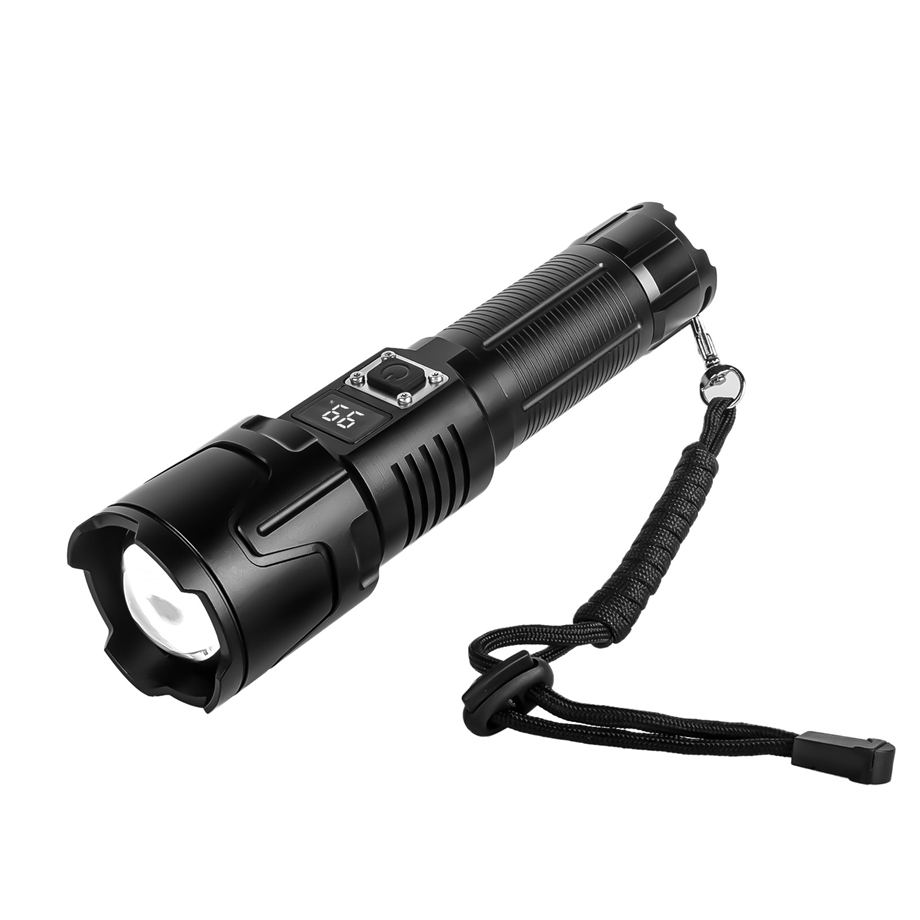How Flashlight Manufacturers Are Reducing Environmental Impact in the Outdoor Sector

You may not realize it, but the outdoor sector faces growing environmental challenges. Flashlight manufacturers are stepping up to address these issues. They now use eco-friendly materials, like recycled metals and biodegradable plastics, to reduce waste. Energy-efficient designs, such as LED technology, help conserve power. Many companies also embrace circular economy principles by creating durable products that last longer. These efforts show how flashlight manufacturers are reducing environmental impact in the outdoor sector while promoting sustainability.
Key Takeaways
Pick flashlights made from recycled or biodegradable materials to help the planet.
Use LED or solar-powered flashlights to save energy and be eco-friendly.
Check if brands care about the environment before buying their products.
Buy strong and fixable flashlights to create less trash and save money.
Recycle old flashlights to reuse materials and keep trash out of landfills.
Environmental Challenges in Traditional Flashlight Production
Material Waste and Non-Recyclable Components
Traditional flashlights often rely on materials that are difficult to recycle. Many of these components, such as Acrylonitrile Butadiene Styrene (ABS), are derived from petroleum. ABS is durable but becomes non-recyclable when mixed with other materials. High-Density Polyethylene (HDPE), another common plastic, faces similar challenges. These materials contribute to long-term waste in landfills. Batteries also add to the problem. They often contain hazardous substances like cadmium, lead, and mercury. When improperly disposed of, these materials can contaminate soil and water. You can see how these non-recyclable components create significant environmental challenges.
Energy Inefficiency in Flashlight Design
The production and operation of traditional flashlights consume large amounts of energy. Manufacturing processes often depend on electricity from coal power plants. This reliance increases air pollution and carbon emissions. Older flashlight designs also use inefficient bulbs, which waste energy as heat. These inefficiencies mean you need to replace batteries more frequently, further increasing energy consumption. By understanding these issues, you can appreciate why energy-efficient designs are essential for reducing environmental harm.
Environmental Impact of Disposable Batteries
Disposable batteries are a major source of pollution. When thrown away, they release harmful chemicals into the environment. Recycling batteries is a better option, but it comes with challenges. The process is energy-intensive and not all metals can be recycled. In some cases, recycling costs more than mining new materials. Flashlights that rely on disposable batteries also contribute to waste during production. This cycle of waste and pollution highlights the need for sustainable alternatives. By choosing rechargeable or solar-powered options, you can help reduce this impact.
Sustainable Strategies Adopted by Flashlight Manufacturers

Use of Recycled and Sustainable Materials
Biodegradable Plastics and Recycled Metals
Flashlight manufacturers now use biodegradable plastics and recycled metals to reduce waste. Biodegradable plastics break down naturally, leaving no harmful residues. These materials replace traditional petroleum-based plastics, which take centuries to decompose. Recycled metals, such as aluminum and steel, also play a key role. By reusing metals, manufacturers conserve natural resources and lower energy use during production. When you choose flashlights made with these materials, you support efforts to reduce landfill waste and pollution.
Reducing Packaging Waste
Packaging waste contributes significantly to environmental harm. Many flashlight manufacturers now use minimal and eco-friendly packaging. They opt for recycled cardboard or biodegradable materials instead of plastic. Some companies even eliminate unnecessary packaging altogether. This shift reduces the amount of waste that ends up in landfills. By selecting products with sustainable packaging, you can help reduce the environmental footprint of your outdoor gear.
Energy-Efficient Designs and Renewable Power Sources
LED Technology for Lower Energy Consumption
LED technology has transformed flashlight design. LEDs use far less energy than traditional incandescent bulbs. They also last much longer, reducing the need for frequent replacements. This energy efficiency helps conserve power and reduces the environmental impact of flashlight use. When you choose LED flashlights, you save energy and contribute to sustainability.
Solar-Powered and Rechargeable Flashlights
Solar-powered and rechargeable flashlights offer renewable energy solutions. Solar-powered models harness sunlight, eliminating the need for disposable batteries. Rechargeable flashlights use lithium-ion batteries, which can be recharged hundreds of times. These options reduce waste and save money in the long run. By switching to these energy-efficient designs, you can enjoy reliable lighting while protecting the environment.
Circular Economy Principles in Flashlight Manufacturing
Designing for Durability and Repairability
Durable and repairable flashlights align with circular economy principles. Manufacturers now design products that last longer and can be easily repaired. This approach reduces the need for replacements and minimizes waste. When you invest in durable flashlights, you help extend the product lifecycle and reduce environmental impact.
Recycling Programs for End-of-Life Products
Some manufacturers offer recycling programs for old flashlights. These programs ensure that materials like metals and plastics are recovered and reused. Recycling reduces the demand for new raw materials and prevents waste from ending up in landfills. By participating in these programs, you can support a more sustainable approach to flashlight disposal.
Real-World Examples of Sustainable Flashlight Manufacturers

Companies Leading the Way in Eco-Friendly Flashlights
BioLite: Innovations in Sustainable Materials
BioLite has become a leader in sustainable flashlight production. The company uses eco-friendly materials like recycled plastics and metals in its designs. These materials reduce waste and conserve natural resources. BioLite also focuses on creating multi-functional products. For example, some of their flashlights double as portable power banks. This approach minimizes the need for additional devices, reducing overall environmental impact. By choosing BioLite products, you support a brand committed to sustainability and innovation.
MPOWERD: Renewable Energy-Powered Flashlights
MPOWERD specializes in renewable energy-powered flashlights. Their solar-powered models, such as the Luci series, provide reliable lighting without disposable batteries. These flashlights are lightweight and durable, making them perfect for outdoor adventures. MPOWERD also partners with global organizations to distribute solar lights in underserved communities. This initiative reduces reliance on kerosene lamps, which harm the environment and human health. When you purchase MPOWERD products, you contribute to a cleaner planet and support social impact projects.
Industry Collaborations and Certifications
Partnerships Promoting Sustainability Standards
Many flashlight manufacturers collaborate with organizations to promote sustainability standards. These partnerships help develop eco-friendly practices across the industry. For instance, some companies work with environmental groups to source sustainable materials. Others join initiatives that encourage energy-efficient designs. These collaborations ensure that manufacturers adopt practices that benefit both the environment and consumers. By supporting brands involved in such partnerships, you encourage the industry to prioritize sustainability.
Certifications for Eco-Friendly Products
Certifications play a vital role in identifying eco-friendly flashlights. Look for products with certifications like:
UL Certification: Ensures LED lights meet safety and quality standards through independent testing.
eco-INSTITUT: Verifies low emissions and pollutants, focusing on indoor air quality.
GreenGuard: Certifies products with low Volatile Organic Compounds (VOCs), reducing indoor air pollution.
These certifications give you confidence in the product's environmental and safety standards. By choosing certified flashlights, you help reduce harmful impacts on the planet.
How Consumers Can Support Sustainable Flashlight Practices
Tips for Choosing Environmentally-Friendly Flashlights
Look for Recycled or Sustainable Materials
When selecting a flashlight, you should prioritize products made from recycled or sustainable materials. Many manufacturers now use eco-friendly options like recycled metals or biodegradable plastics. These materials reduce waste and conserve natural resources. Additionally, consider whether the flashlight was produced using energy-efficient manufacturing processes and ethical labor practices. By choosing products that meet these criteria, you not only minimize environmental impact but also support social responsibility.
Opt for Rechargeable or Solar-Powered Options
Rechargeable and solar-powered flashlights offer several advantages over traditional battery-powered models:
Environmentally Friendly: Solar-powered flashlights rely on renewable energy, reducing the need for disposable batteries that harm the environment.
Cost-effective: Rechargeable options save you money over time by eliminating the need for frequent battery replacements.
Convenient: Solar-powered models can charge using sunlight, making them perfect for outdoor activities where electrical outlets are unavailable.
Reliable: These flashlights provide consistent lighting as long as sunlight is available, ensuring you’re never left in the dark.
Switching to these options helps you reduce waste and lower your environmental footprint.
Supporting Brands Committed to Sustainability
Researching Manufacturer Practices
Before purchasing a flashlight, take time to research the manufacturer’s sustainability practices. Look for companies that use eco-friendly materials, adopt energy-efficient designs, and follow ethical production standards. Many brands also partner with environmental organizations to promote sustainable practices. By supporting these companies, you encourage the industry to prioritize sustainability and innovation.
Prioritizing Durability and Repairability
Durability and repairability are essential factors to consider when choosing a flashlight. Products designed to last longer and be easily repaired reduce waste and support environmental sustainability. This approach also benefits you by saving money on replacements. Additionally, brands that focus on these principles often gain a better reputation among eco-conscious consumers. Supporting such brands ensures they remain competitive and continue to adopt sustainable practices.
By making informed choices, you can contribute to the efforts of flashlight manufacturers to reduce their environmental impact. Together, consumers and manufacturers can create a more sustainable outdoor sector.
Flashlight manufacturers are transforming the outdoor sector by adopting sustainable practices. They use innovative materials, energy-efficient designs, and circular economy principles to reduce environmental harm. These efforts not only conserve resources but also improve operational efficiency and attract eco-conscious buyers. For example, eco-friendly supply chains save energy and cut waste, while green branding fosters customer loyalty.
As a consumer, your choices matter. Businesses value sustainability because it builds trust and reputation. By supporting brands that prioritize ethical practices, you can influence the industry to adopt greener methods. Together, you and manufacturers can protect the environment for future generations.
FAQ
What makes a flashlight eco-friendly?
Eco-friendly flashlights use sustainable materials like recycled metals or biodegradable plastics. They often feature energy-efficient designs, such as LED bulbs, and rely on renewable power sources like solar energy or rechargeable batteries. These features reduce waste and conserve resources.
Are rechargeable flashlights better for the environment?
Yes, rechargeable flashlights are better. They eliminate the need for disposable batteries, which often end up in landfills. Rechargeable models reduce waste and save energy over time. They also cost less in the long run since you don’t need to buy replacement batteries.
How can I tell if a flashlight is sustainably made?
Look for certifications like UL or GreenGuard, which verify eco-friendly standards. Check if the manufacturer uses recycled or biodegradable materials. Research the brand’s sustainability practices, such as energy-efficient production methods or recycling programs for old products.
Do solar-powered flashlights work in low-light conditions?
Most solar-powered flashlights store energy in built-in batteries. This allows them to work even when sunlight is unavailable. However, their performance depends on the battery’s charge level. For consistent use, ensure the flashlight is fully charged before heading out.
Why should I choose durable flashlights?
Durable flashlights last longer, reducing the need for replacements. This minimizes waste and conserves resources. Repairable designs also let you fix issues instead of discarding the product. Choosing durable options supports sustainability and saves you money over time.
See Also
Essential Factors and Trends in Choosing Flashlight Suppliers
Understanding LED Technology and Manufacturing in Flashlight Production
Enhance Outdoor Safety by Buying Mini Pocket Flashlights
Boosting Profits Through Strategic Flashlight Wholesale Sourcing
Enhancing Brand Visibility with Custom Promotional Flashlights
